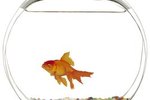
A goldfish can go from haute to humdrum in a hurry if she loses her color. Before turning to the pet store aisles to find a remedy to restore her allure, determine the cause of the color loss. A health issue could be the cause of the fading, and it could be deadly if not treated. If the fading's not due to a health concern, unnecessary treatment could be harmful, too.
Genetics
Goldfish tend to change color in their first year of life. This is strictly due to genetics and has nothing to do with care, feeding or health. The amount of change and the final color can be hard to determine unless the fish have been bred carefully. In this case, the young often change to a color similar to at least one of the parents. Black goldfish, like moors, often lose their color over time. They often fade from a rich velvety black to a dark shade of gray with gold highlights.
Light
Keeping a goldfish in dim light can cause it to lose its bright color. The same is true for a goldfish kept in constantly running water, like a stream. On the other hand, bright sunlight will improve a goldfish’s color, brightening up soft yellows, reds and pale orange. Goldfish kept in ponds have brighter colors than their indoor aquarium-kept counterparts. For the brightest color, keep your fish tank in an area that is well-lit, but out of direct sunlight, which can overheat the water.
Illness
Bacterial infections are not the most common cause of color change in goldfish, but they are the most serious. Bold colors like orange and red will usually become lackluster and dull or faded. Your fish will usually show other signs of illness as well, including lethargy and weight loss. Tuberculosis can cause loss of color. This disease affects your goldfish’s internal organs and is often fatal. Other symptoms of tuberculosis include nodules that develop into ulcers, rapid weight loss and unnaturally protruding eyes. Keep your tank clean, quarantine new fish, and make sure nitrate and ammonia levels are at acceptable levels to prevent infections and related color loss.
Parasites
Skin flukes are small wormlike pests that feed on a goldfish’s skin. A serious infestation can cause a color change as the fish excretes mucus to fight off the flukes. Signs of skin flukes include rubbing, lethargy, clamped fins and lesions. An infestation often leads to a bacterial illness as well, since the damaged skin is susceptible to infection. Keep new fish and live plants in quarantine for at least four weeks before adding them to the tank to prevent skin flukes. Regular treatment with a worming medication designed for fish can also stop these pests from ruining your fish's color.
Healing
A goldfish that has been bumped around, often during transport to a new home, may develop dark spots on its body and fins. This loss of color is temporary. The spots are similar to bruises on humans. As your goldfish heals, his normal color will return. This process may take several weeks. It is difficult to prevent this type of damage, but careful handling of your fish between the store and home can reduce it.
References
Photo Credits
-
Hemera Technologies/PhotoObjects.net/Getty Images




